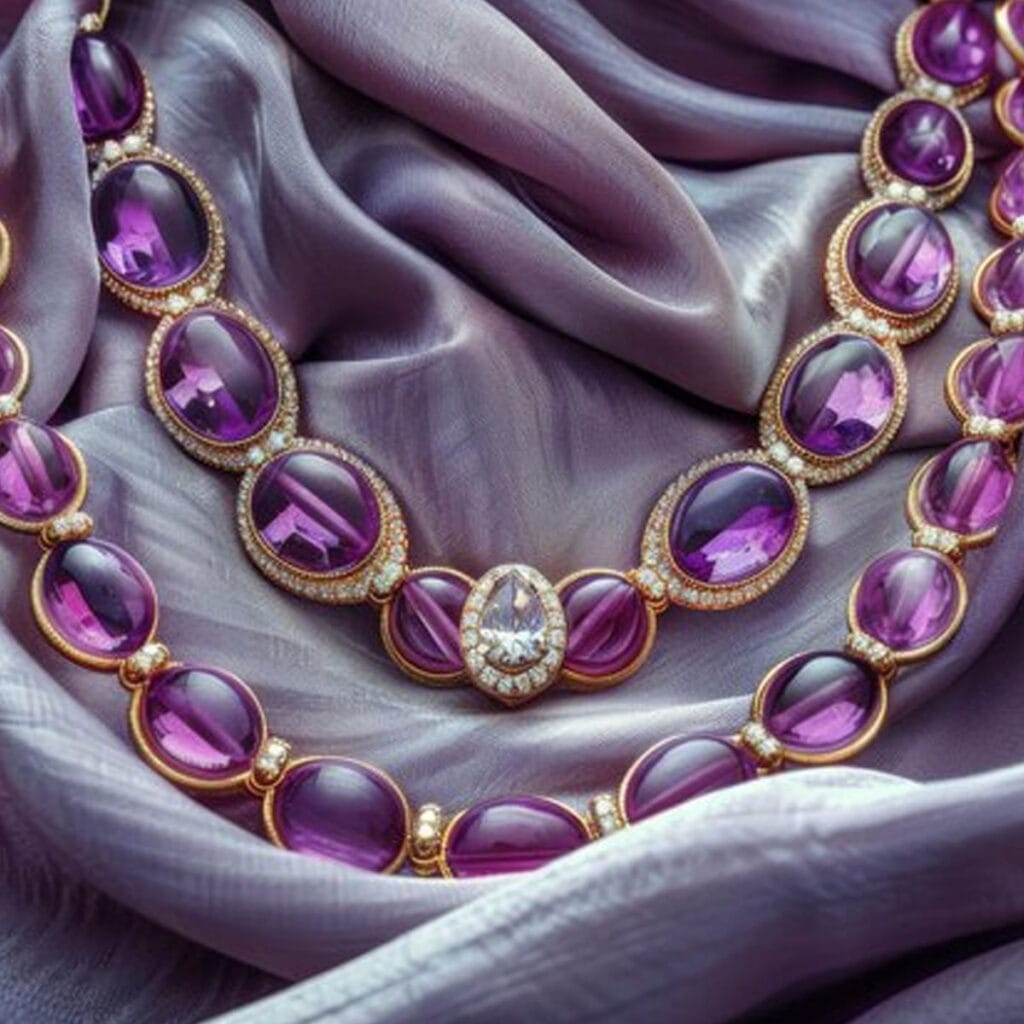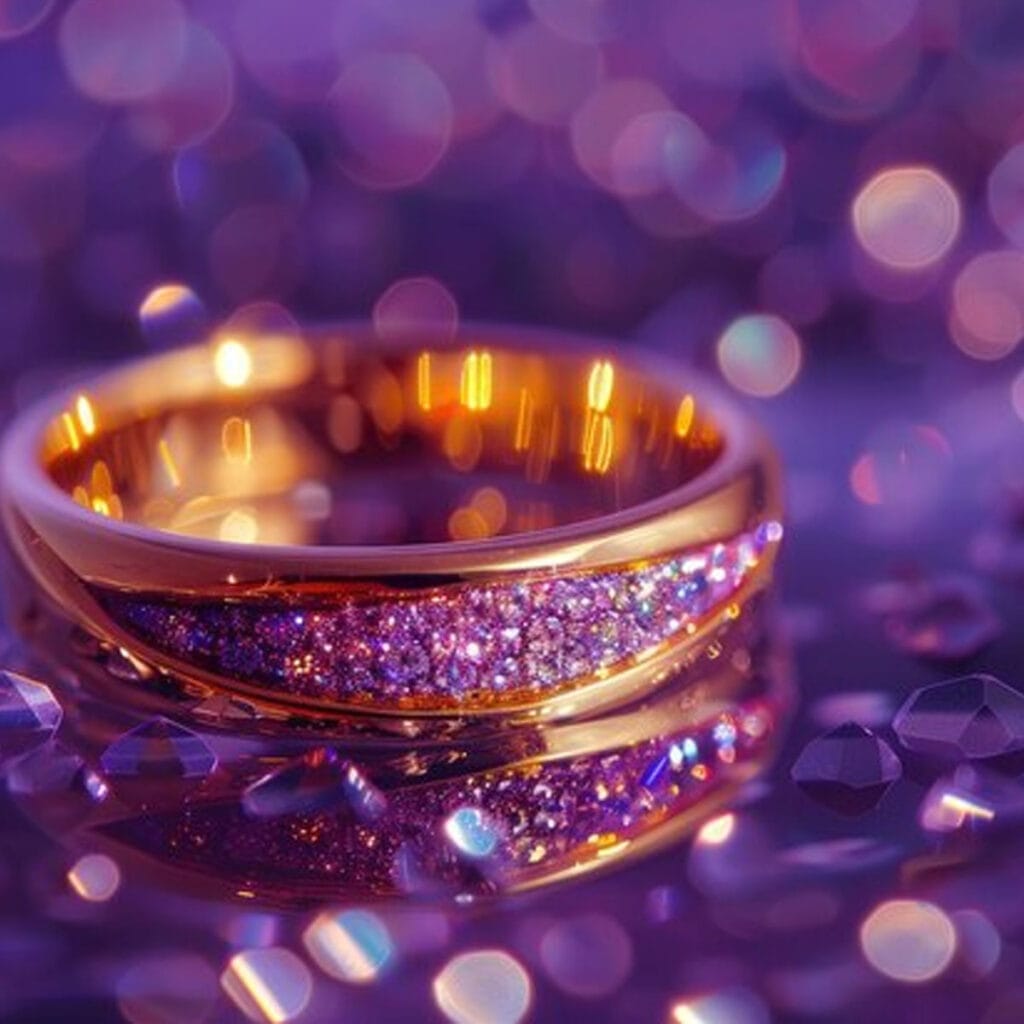A century ago, shoppers equated luxury with yellow lustre and little else. Today, collectors hunt rarities that fuse scientific ingenuity with artistic intent, and purple gold sits at the centre of that quest. Its hue is not a surface treatment or a marketing ploy. Instead, it is born deep inside a rigid crystal lattice where atoms snap into position like soldiers on parade, locking in a violet tone that never fades. For buyers who scour Pinterest and auction catalogues for the next conversation starter, the material answers a rising search query in plain terms: what is purple gold, and why does it matter?
The answer begins with emotion. Colour triggers instinct quicker than any hallmark, and a violet metal speaks to individuality in a market flooded with near-identical alloys. Whether you are scanning an Instagram reel or standing beneath the soft spotlights of Bond Street, that first flash of royal purple flips a mental switch. It feels daring, unrepeatable, almost forbidden, yet its core purity exceeds that of many shop-floor pieces. The psychological punch is immediate, and the commercial pull is just as strong.
Born in the cleanroom, raised in the atelier
The story opens not in a workshop but in the microchip facilities of the 1960s, where engineers noticed a brittle violet crust forming between 18k gold bonding wires and aluminium pads. Nicknamed the purple plague, this unwanted crystal shattered circuits and ruined yields. What sabotaged semiconductors, however, fascinated metallurgists. They discovered an intermetallic compound called AuAl₂, comprising approximately 79% gold and 21% aluminium. Strike that proportion, and you gain the shade; miss it by a few percentage points, and the colour vanishes.
Decades later, jewellers revisited the phenomenon with a craftsman’s eye. They borrowed the vacuum furnaces of aerospace labs, poured molten metal under argon, and cooled the ingots slower than bread dough in a proving drawer. The result was a hard, porcelain-like block ready for lapidary wheels rather than rolling mills. It could be sawn, ground and polished, yet any attempt to bend it ended in a snap. Makers quickly learned to treat the substance as a stone, not a ductile alloy, carving cabochons and inlays that sit comfortably beside diamonds.
Fun Fact: During the restoration of Granada’s Alhambra palace, conservators noticed a faint lilac glimmer on centuries-old gilded tin panels. A microscopic study showed that nature had replicated the AuAl₂ trick by sculpting gold nanoparticles just 70 nanometres wide – proof that, under perfect conditions, purple gold can appear without human intervention.
From semiconductor plague to couture prestige
Rarity is not solely a question of mining output. Production hurdles and labour scarcity push purple gold jewellery into an elite bracket all of its own. Each batch demands high-vacuum casting equipment, strict temperature curves and a jeweller with a gem-cutter’s touch. The scrap rate is punishing: one wrong parameter and the ingot wrinkles, pores or discolours beyond salvage. Add the necessary hand-finishing, and you see why the material commands a thirty to fifty per cent premium over standard eighteen-karat rings of comparable weight.
Collectors pay willingly because every finished piece carries two intertwined narratives. First comes the technical saga – advanced metallurgy turned fashion statement. Second is the tale of personal involvement. Off-the-shelf stock is practically non-existent in the UK, so buyers must commission work directly. They consult with designers, source the raw AuAl₂ through specialist suppliers, then watch their vision move from CAD model to casting to final polish. The journey becomes as treasured as the jewel itself, reinforcing the emotional bond between owner and object.
The science that locks colour into crystal
Unlike yellow, rose or white gold – all classic solid-solution alloys where atoms float in a shared lattice – AuAl₂ forms an ordered grid with only a handful of slip systems. That microscopic rigidity gifts enviable hardness (250–334 Vickers) yet condemns the metal to pronounced brittleness. Drop a finished cabochon on a workshop floor and it may split along a crystal plane rather than dent. The paradox mirrors ceramic behaviour, so successful artisans abandon hammers and embrace diamond tooling instead.
Chemically, the compound’s deep hue arises from its electron band structure. Photons in the green and yellow regions are absorbed, leaving the eye to register reflected red and blue together as purple. Because the pigment resides within the lattice itself, scratches reveal the same shade beneath. Plating cannot fake this permanence; only genuine AuAl₂ wears its colour throughout.
Why does hardness not equal durability
Consumers often equate scratch resistance with toughness; however, the two qualities diverge dramatically in this regard. A polished surface resists micro-abrasions better than most white gold, but its structural integrity is closer to that of opal than to platinum. Laboratory sweat tests have even shown aluminium ions leaching under acidic conditions, hinting at long-term patina shifts if pieces come into contact with chlorinated pools or household bleaches.
Designers mitigate risk through engineering. In high-impact items such as engagement rings, they set purple segments inside platinum channels, creating a sacrificial frame that absorbs knocks. Pendants and earrings, which seldom come into contact with hard surfaces, allow larger, uninterrupted stones of the metal to shine. The result is functional wearability without sacrificing the aesthetic shock that first sparked the buyer’s interest.
Engineering limits and design ingenuity
Strip away romance and purple gold reveals a blunt fact: any ring band built entirely from AuAl₂ courts disaster. The material’s ceramic attitude means a single knock against a granite countertop can open a hairline crack that races around the shank before the owner even realises. Yet jewellers refuse to surrender. Instead, they deploy three protective strategies that balance aesthetics with physics:
- Inlay channels – a slender ribbon of colour sunk into platinum or tough white gold, so impacts strike the host metal first
- Bezel-set cabochons – the purple section behaves like a stone, hugged by a continuous rim that guards its edges
- Halo frames – a raised border of palladium or diamond melee forms a bumper, keeping daily bumps at bay
These solutions do not weaken the visual drama. In fact, the contrast between cool white metals and the saturated violet centre amplifies the wow factor, turning risk into reward. When clients discuss a bespoke engagement ring, they often arrive at an inlay concept within minutes because it feels logical, beautiful and safe.
Valuation beyond the bullion line
Investors sometimes ask why a jewel containing seventy-nine per cent gold can sell above pieces that carry ninety-five per cent platinum. The answer lies in hidden overheads. Every cast begins inside a vacuum furnace that costs more to operate per hour than many jewellers earn in a day. Scrap rates soar, labour includes both metallurgists and lapidaries, and finished inventory ties up capital because customers rarely share identical taste.
Add these layers and raw cost per gram climbs roughly thirty to fifty per cent above standard eighteen-karat figures, pushing purple gold into the league of boutique alloys such as mokume-gane or black rhodium treatments. The market, however, is more than willing to pay. Collectors value scarcity, while digital content creators value stories and the ability to share them. A short video showing a violet ingot shattering under pressure has already garnered millions of TikTok views, fueling demand at the luxury end.


Caring for a metallic gemstone
Owners must rewrite their cleaning routine. Think of AuAl₂ as a fragile opal with a golden heart:
- Prepare lukewarm water plus a few drops of mild dish soap
- Soak for ten minutes, then coax away residue with a baby-soft brush
- Rinse thoroughly, pat dry with microfibre, never paper towel
- Keep clear of chlorine, bleach and ammonia, which can leach aluminium ions and dull the hue
- Store pieces separately in cloth pouches so harder gems cannot abrade the surface
Ultrasonic baths are best avoided because high-frequency waves may propagate micro-fractures. When in doubt, a professional jeweller experienced with fine jewellery maintenance should handle any deep clean.
Sourcing within the UK bespoke scene
Walk into a conventional high-street showroom and you will not find a ready-made purple gold solitaire. The supply chain is too specialised, and volumes are too low. Instead, two practical routes serve British buyers:
- Material suppliers – firms like Ore Metals ship pre-cast cabochons and blank bars certified at 79 % gold. Designers purchase these components, then build custom mounts around them.
- Collaboration with casters – outfits in Birmingham’s Jewellery Quarter offer private alloy runs inside argon atmospheres. A client provides design files and accepts a small minimum charge for furnace time. The fresh ingot moves straight to the lapidary bench for shaping and polishing.
Either route demands patience, yet the time investment strengthens provenance. Clients receive certificates confirming composition plus studio photographs of each production step, perfect for social posts or future insurance claims.
Ethical considerations
Several manufacturers highlight the use of scrap circuit boards as a feedstock for both gold and aluminium. This recycling loop carries weight with shoppers seeking sustainable gold options. While the carbon footprint per gram remains higher than ordinary alloys, buyers offset guilt by choosing a piece destined to stay in circulation for generations rather than a fashion item headed for landfill.
Pairings that set the tone
Designers exploit colour psychology to push purple gold in three directions:
- Royal contrast – rich yellow gold prongs around a violet core evoke courtly regalia and command attention at formal events
- Modern minimalism – platinum bezel, black enamel accents and geometric lines create a look adored by design-led couples
- Soft romance – rose gold shoulders paired with lavender spinel yield a blended, feminine palette ideal for vintage-inspired styles
Looking ahead: research on tougher variants
Patent archives reveal constant experimentation with third-element micro-additions and nano-grain processing. Palladium at two per cent shows promise, as does spark-plasma sintering that compacts powder into dense billets with fewer internal voids. If one of these techniques can enhance fracture toughness without compromising colour, the runway for wider adoption grows longer. Until then, AuAl₂ remains a speciality item, and that exclusivity is part of the allure.
Action: How to decide if purple gold is for you
Shoppers curious about this material should perform a simple checklist:
- Do you enjoy conversation-starting jewellery that feels almost like wearable tech?
- Are you comfortable commissioning work and waiting ten to twelve weeks for completion?
- Will the chosen piece avoid daily knocks, or can the design shield it?
- Are you prepared to follow careful cleaning and storage rituals?
If the answers lean yes, the reward is a jewel unlike any other —a proof point that passion and science can coexist elegantly. If they learn no, safer alloys exist. True luxury sits in informed choice.
Final thought
Purple gold is a paradox balanced on a blade edge: stubbornly brittle yet fiercely scratch resistant, ancient in composition yet futuristic in vibe. It reminds us that progress seldom marches in straight lines. Sometimes it glimmers in unexpected colours, tempting those brave enough to rewrite the rules of wear. Choose wisely, care well, and your violet treasure will outlive fashion cycles like a secret whispered through generations. Fortune favours the bold.

